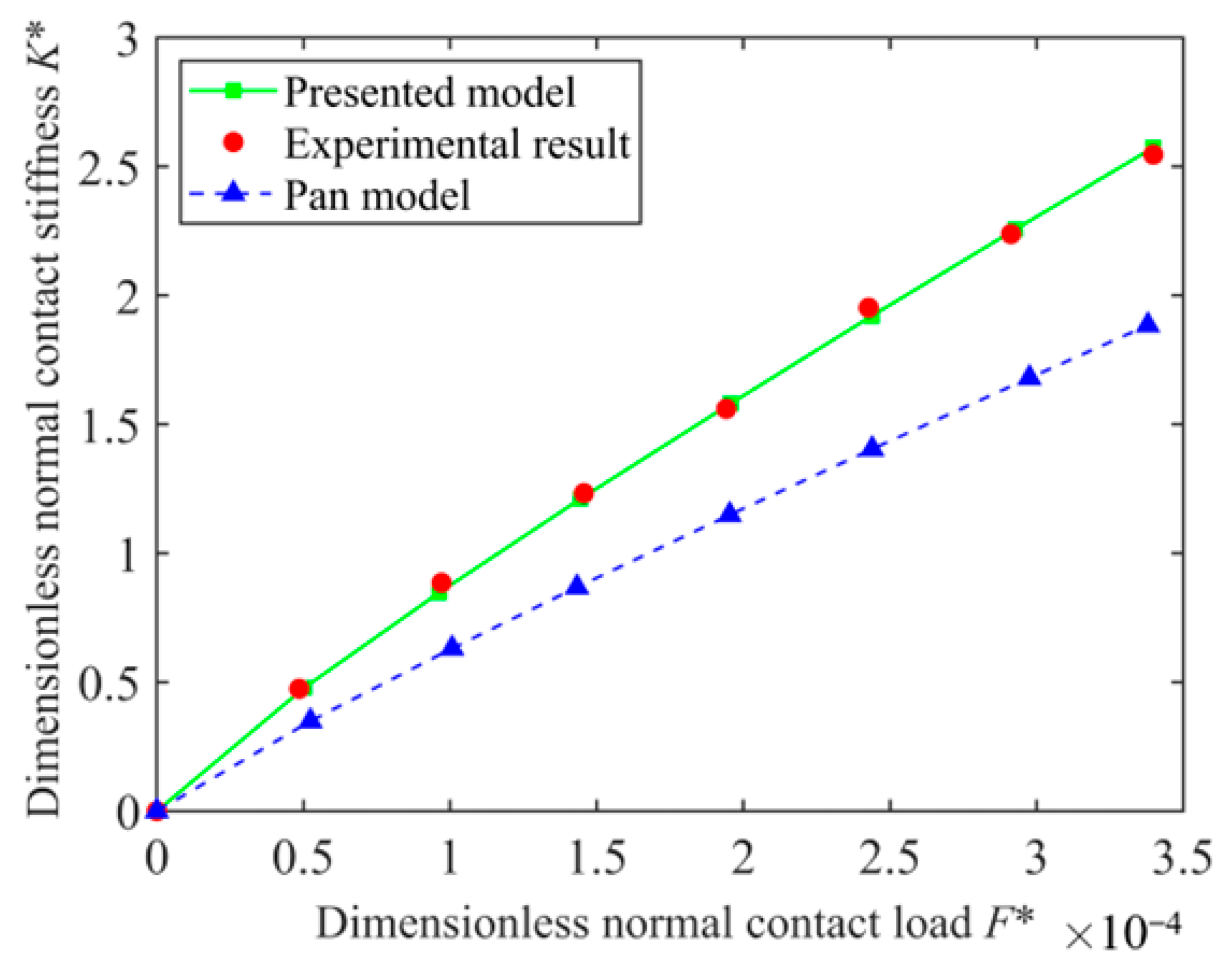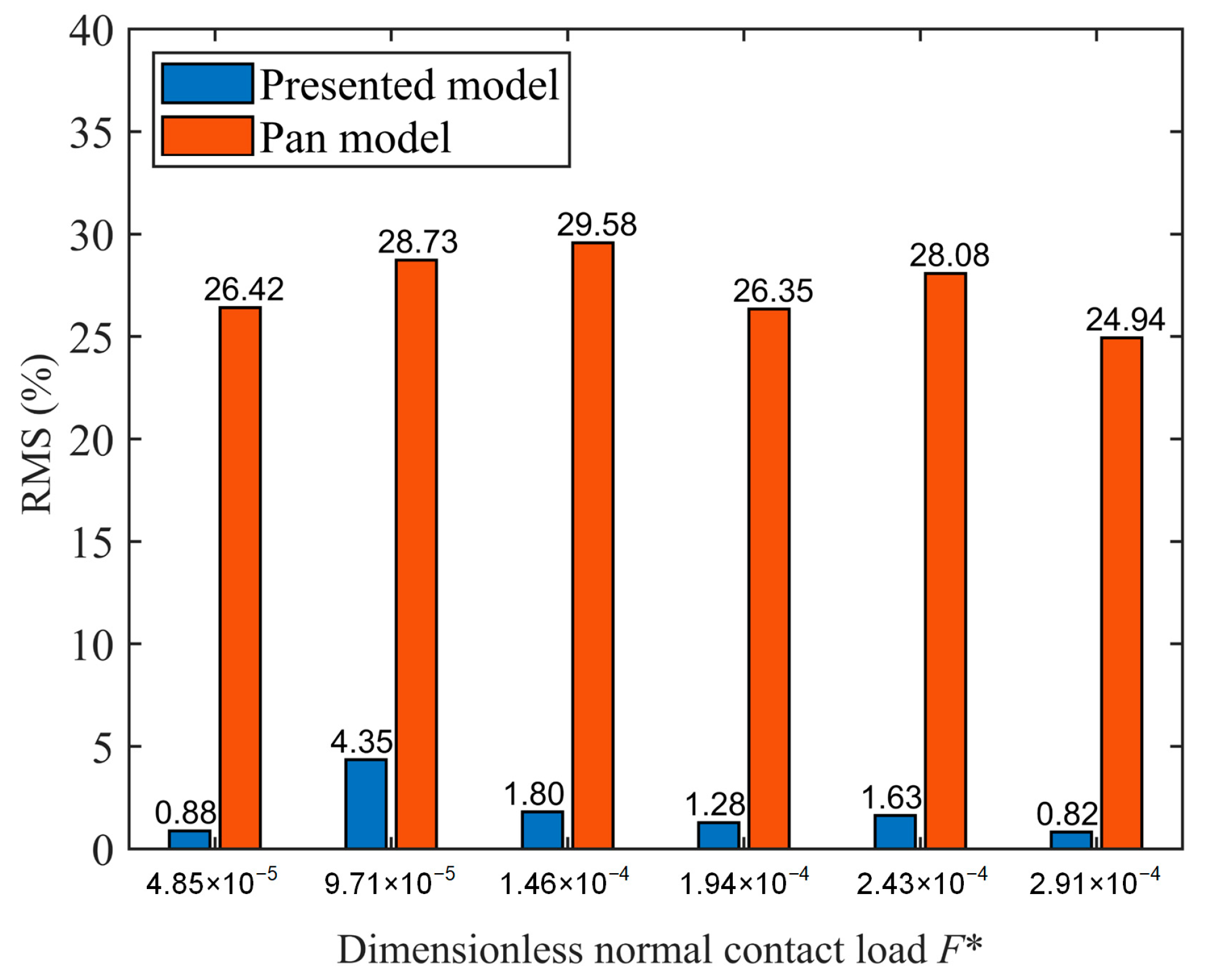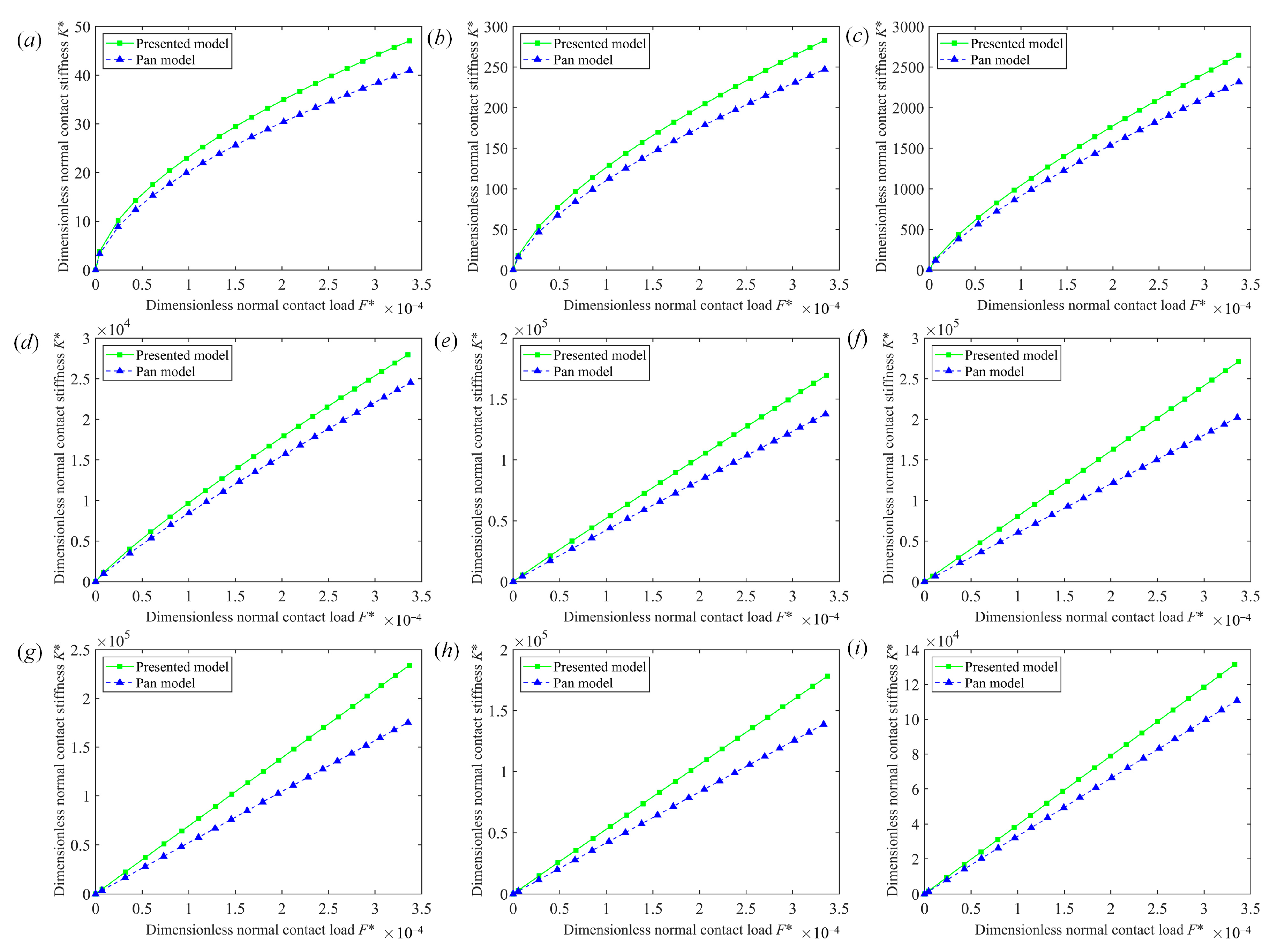A Novel Three-Dimensional Fractal Model for the Normal Contact Stiffness of Mechanical Interface Based on Axisymmetric Cosinusoidal Asperity
Abstract
1. Introduction
1.1. Context
1.2. Literature Review
1.3. New Approach
2. Establishment of the Hypothetical Surface
2.1. The Shape of a Single Asperity
2.2. The Hypothetical Three-Dimensional Surface
3. Contact Analysis of a Single Asperity
3.1. Elastic Deformation Stage
3.2. Plastic Deformation Stage
3.3. Elastic–Plastic Deformation Stage
4. Establishment of Interface Contact Model
5. Results and Discussion
5.1. Numerical Simulation and Experimental Test
5.2. Comparison of Results under Different Fractal Parameters
5.2.1. Fractal Dimension D
5.2.2. Scale Coefficient G
6. Conclusions
- (1)
- The analytical hypothetical 3D surface based on the axisymmetric cosinusoidal asperity is established. In the hypothetical surface, the shape of asperity is represented by an axisymmetric cosinusoidal body, and the distribution of the asperity follows the truncated asperity size distribution function.
- (2)
- Contact mechanics are used to analyze the contact deformation process of asperity. Then, combining the contact deformation analysis results of asperity and the truncated asperity size distribution function, the analytical expressions of the normal contact stiffness and normal contact load of the whole interface are obtained. The theoretical analytical model of normal contact stiffness of mechanical interface is finally obtained.
- (3)
- The numerical simulation results of the presented model are compared with the experimental results and the Pan model. The comparison results show that the maximum relative error between the presented model and the experimental results is 4.35%, while the maximum relative error between the Pan model and the experimental results is 29.58%. The comparison results verify the accuracy of the presented model.
- (4)
- The influence of different fractal parameters on normal contact stiffness is discussed. The simulation results show that under the same normal contact load, the normal contact stiffness increases first and then decreases with the increase of D. The normal contact stiffness decreases monotonically with the increase of G. In this paper, the rationality of the simulation results is reasonably explained in combination with the shape of the asperity.
Author Contributions
Funding
Data Availability Statement
Conflicts of Interest
References
- Chen, Y.; Li, P.; Sun, J.; Shang, M.; Shao, L. Fractal Model of Contact Thermal Stiffness. Machines 2022, 10, 464. [Google Scholar] [CrossRef]
- Yin, D.; Zhang, X.; Wen, S.; Lan, G.; Chen, Y. A Normal Contact Stiffness Statistical Model of Joint Interface considering Hardness Changes. Adv. Mater. Sci. Eng. 2022, 2022, 2160508. [Google Scholar] [CrossRef]
- Sun, X.; Meng, C.; Duan, T. Fractal model of thermal contact conductance of two spherical joint surfaces considering friction coefficient. Ind. Lubr. Tribol. 2022, 74, 93–101. [Google Scholar] [CrossRef]
- Ma, X.; Tong, K. Study on Contact Mechanics Modeling of Joint Surface Containing Composite Materials. Compos. Mech. Comput. Appl. Int. J. 2022, 13, 9–21. [Google Scholar] [CrossRef]
- Yin, Q.; Dong, G.; Yin, G.; Heng, L.; Wang, L. Research on modeling and identification of machine tool joint dynamic characteristics. J. Adv. Mech. Des. Syst. Manuf. 2019, 13, JAMDSM0046. [Google Scholar] [CrossRef]
- Yang, Y.; Zou, P.; Dai, X.; Yang, B.; Gao, F. Parametric sensitivity research of interference-fit bolted single-lap laminates joint based on an improved analytical stiffness model. J. Compos. Mater. 2021, 55, 4513–4526. [Google Scholar] [CrossRef]
- Liu, W.; Shen, J.; Cheng, S.; Wang, S. A Multi-Scale Stiffness Fractal Model of Joint Interfaces. Russ. Phys. J. 2021, 64, 1261–1280. [Google Scholar] [CrossRef]
- Zhao, G.; Li, Y.; Zhang, Z.; Xiong, Z.; Shengxiang, L.; Wang, M. Simulation and experiment of secondary contact stiffness of rough surface. J. Mech. Sci. Technol. 2022, 36, 1079–1087. [Google Scholar] [CrossRef]
- Li, D.; Botto, D.; Li, R.; Xu, C.; Zhang, W. Experimental and Theoretical Studies on Friction Contact of Bolted Joint Interfaces. Int. J. Mech. Sci. 2022, 236, 107773. [Google Scholar] [CrossRef]
- Mandelbrot, B.B. Fractals, form, chance and dimension. Math. Intell. 1977, 1, 35–37. [Google Scholar] [CrossRef]
- Sayles, R.S.; Thomas, T.R. Surface topography as a nonstationary random process. Nature 1978, 271, 431–434. [Google Scholar] [CrossRef]
- Zhang, X.; Jackson, R. An Analysis of the Multi-scale Structure of Surfaces with Various Finishes. Tribol. Trans. 2016, 60, 121–134. [Google Scholar] [CrossRef]
- Majumdar, A.; Bhushan, B. Role of Fractal Geometry in Roughness Characterization and Contact Mechanics of Surfaces. J. Tribol. 1990, 112, 205–216. [Google Scholar] [CrossRef]
- Majumdar, A.; Bhushan, B. Fractal Model of Elastic-Plastic Contact between Rough Surfaces. J. Tribol. 1991, 113, 1–11. [Google Scholar] [CrossRef]
- Jiang, S.; Zheng, Y.; Zhu, H. A Contact Stiffness Model of Machined Plane Joint Based on Fractal Theory. J. Tribol. 2010, 132, 011401. [Google Scholar] [CrossRef]
- Tian, H.; Zhong, X.; Zhao, C.; Zhao, X.; Fang, Z.; Liu, F.; Zhu, D.; Lin, W.; Yan, H. One Loading Model of Joint Interface Considering Elastoplastic and Variation of Hardness with Surface Depth. Jixie Gongcheng Xuebao/J. Mech. Eng. 2015, 51, 90–104. [Google Scholar] [CrossRef]
- Zhang, Y.; Lu, H.; Zhang, X.; Ling, H.; Fan, W.; Bao, L.; Guo, Z. A normal contact stiffness model of machined joint surfaces considering elastic, elasto-plastic and plastic factors. Proc. Inst. Mech. Eng. Part J J. Eng. Tribol. 2019, 234, 135065011986780. [Google Scholar] [CrossRef]
- Wang, N.; Liu, H.; Liu, Y. Normal fractal contact stiffness model among three disks of rod-fastening rotor system with considering friction and the asperities interaction. Ind. Lubr. Tribol. 2021, 73, 652–659. [Google Scholar] [CrossRef]
- Ausloos, M.; Berman, D. A Multivariate Weierstrass-Mandelbrot Function. Proc. R. Soc. A Math. Phys. Eng. Sci. 1985, 400, 331–350. [Google Scholar] [CrossRef]
- Yan, W.; Komvopoulos, K. Contact analysis of elastic-plastic fractal surfaces. J. Appl. Phys. 1998, 84, 3617–3624. [Google Scholar] [CrossRef]
- Komvopoulos, K.; Ye, N. Three-Dimensional Contact Analysis of Elastic-Plastic Layered Media with Fractal Surface Topographies. J. Tribol. 2001, 123, 632–640. [Google Scholar] [CrossRef]
- Pan, W.; Li, X.; Wang, L.; Guo, N.; Mu, J. A normal contact stiffness fractal prediction model of dry-friction rough surface and experimental verification. Eur. J. Mech.-A/Solids 2017, 66, 94–102. [Google Scholar] [CrossRef]
- Jiang, K.; Liu, Z.; Yang, C.; Zhang, C.; Tian, Y.; Zhang, T. Effects of the joint surface considering asperity interaction on the bolted joint performance in the bolt tightening process. Tribol. Int. 2022, 167, 107408. [Google Scholar] [CrossRef]
- Ghaednia, H.; Wang, X.; Saha, S.; Xu, Y.; Sharma, A.; Jackson, R. A Review of Elastic-Plastic Contact Mechanics. Appl. Mech. Rev. 2018, 69, 060804. [Google Scholar] [CrossRef]
- Chu, N.; Jackson, R.; Wang, X.; Gangopadhyay, A.; Ghaednia, H. Evaluating Elastic-Plastic Wavy and Spherical Asperity-Based Statistical and Multi-Scale Rough Surface Contact Models with Deterministic Results. Materials 2021, 14, 3864. [Google Scholar] [CrossRef]
- Mishra, T.; Rooij, M.; Schipper, D. The effect of asperity geometry on the wear behaviour in sliding of an elliptical asperity. Wear 2021, 470–471, 203615. [Google Scholar] [CrossRef]
- An, Q.; Suo, S.; Lin, F.; Shi, J. A Novel Micro-Contact Stiffness Model for the Grinding Surfaces of Steel Materials Based on Cosine Curve-Shaped Asperities. Materials 2019, 12, 3561. [Google Scholar] [CrossRef]
- Krithivasan, V.; Jackson, R. An Analysis of Three-Dimensional Elasto-Plastic Sinusoidal Contact. Tribol. Lett. 2007, 27, 31–43. [Google Scholar] [CrossRef]
- Johnson, K.; Greenwood, J. An approximate JKR theory for elliptical contacts. J. Phys. D Appl. Phys. 2005, 38, 1042. [Google Scholar] [CrossRef]
- Saha, S.; Xu, Y.; Jackson, R. Perfectly Elastic Axisymmetric Sinusoidal Surface Asperity Contact. J. Tribol. 2015, 138, 031401. [Google Scholar] [CrossRef]
- Komvopoulos, K.; Yan, W. A Fractal Analysis of Stiction in Microelectromechanical Systems. J. Tribol. 1997, 119, 391–400. [Google Scholar] [CrossRef]
- Li, X.; Liang, Y.M.; Guo, H.; Ju, X.; Wen, B.C. Study on equivalent model of generalized clearance of joint surface. Zhendong Gongcheng Xuebao/J. Vib. Eng. 2014, 27, 25–32. [Google Scholar] [CrossRef]
- Abbott, E.J.a.F. Specifying Surface Quality—A Method on Accurate Measurement and Comparison. Mech. Eng. ASME 1933, 55, 569–572. [Google Scholar]
- Johnson, K.L. Contact Mechanics; Cambridge University Press: Cambridge, UK, 1985; pp. 171–189. [Google Scholar]
- Tabor, D.J.N. Hardness of Metals. Nature 1937, 140, 260. [Google Scholar] [CrossRef]
- Wu, M.; Wang, W.; Shi, D.; Song, Z.; Li, M.; Luo, Y. Improved box-counting methods to directly estimate the fractal dimension of a rough surface. Measurement 2021, 177, 109303. [Google Scholar] [CrossRef]






Disclaimer/Publisher’s Note: The statements, opinions and data contained in all publications are solely those of the individual author(s) and contributor(s) and not of MDPI and/or the editor(s). MDPI and/or the editor(s) disclaim responsibility for any injury to people or property resulting from any ideas, methods, instructions or products referred to in the content. |
© 2023 by the authors. Licensee MDPI, Basel, Switzerland. This article is an open access article distributed under the terms and conditions of the Creative Commons Attribution (CC BY) license (https://creativecommons.org/licenses/by/4.0/).
Share and Cite
Wang, W.; An, Q.; Suo, S.; Meng, G.; Yu, Y.; Bai, Y. A Novel Three-Dimensional Fractal Model for the Normal Contact Stiffness of Mechanical Interface Based on Axisymmetric Cosinusoidal Asperity. Fractal Fract. 2023, 7, 279. https://doi.org/10.3390/fractalfract7040279
Wang W, An Q, Suo S, Meng G, Yu Y, Bai Y. A Novel Three-Dimensional Fractal Model for the Normal Contact Stiffness of Mechanical Interface Based on Axisymmetric Cosinusoidal Asperity. Fractal and Fractional. 2023; 7(4):279. https://doi.org/10.3390/fractalfract7040279
Chicago/Turabian StyleWang, Weikun, Qi An, Shuangfu Suo, Guoying Meng, Yibo Yu, and Yuzhu Bai. 2023. "A Novel Three-Dimensional Fractal Model for the Normal Contact Stiffness of Mechanical Interface Based on Axisymmetric Cosinusoidal Asperity" Fractal and Fractional 7, no. 4: 279. https://doi.org/10.3390/fractalfract7040279
APA StyleWang, W., An, Q., Suo, S., Meng, G., Yu, Y., & Bai, Y. (2023). A Novel Three-Dimensional Fractal Model for the Normal Contact Stiffness of Mechanical Interface Based on Axisymmetric Cosinusoidal Asperity. Fractal and Fractional, 7(4), 279. https://doi.org/10.3390/fractalfract7040279





